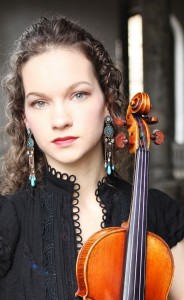Hilary Hahn has been a frequent visitor to Salt Lake City over the years. She returns this weekend to join the Utah Symphony and Thierry Fischer in Erich Wolfgang Korngold’s Violin Concerto. The work was premiered by the legendary violinist Jascha Heifetz in 1947; it uses themes from several of Korngold’s popular film scores.
Also on this weekend’s program are Wolfgang Amadeus Mozart’s Symphony No. 41, Jupiter, and the Adagio from Gustav Mahler’s unfinished Symphony No. 10.
In a recent email interview with Reichel Recommends, the 32-year old violinist talked about the concerto, upcoming projects and some of her favorite pastimes.
RR: You’re doing the Korngold concerto with several U.S. orchestras this season. Is the work new to your repertoire?
HH: I recorded it live on film for the documentary Hilary Hahn: A Portrait about six years ago. I’d played it before then as well. It is a fantastic statement of a work.
RR: Why did you decide to learn it, and what do you like about it?
HH: I wanted to learn the Korngold because it is a big, sweeping work that connects with the audience on a raw emotional level. What I found when I first rehearsed it with orchestra is that, in addition to the musical content, it is a true chamber composition. Within this concerto’s larger ensemble landscape, he wrote snippets of trios, duos and quartets to draw together unusual combinations of instruments. Those layers help add to the intricacy of the concerto. Korngold was specific in his phrasing markings, so it is clear that he wanted the piece to be as expressive as possible. You wind up with a balance of detailed and grand that is fascinating to play with.
RR: From the soloist’s perspective, how demanding is it?
HH: It is demanding! Mostly because the phrases weave in and out of each other, and the rhythm is fluid. That means I always have to be aware of what was just stated; paying attention to everything in the moment; and thinking ahead to the next few elements. It’s fun, though. And I get to hear the orchestra play some beautiful sections all on their own.
RR: The concerto appears on programs rather frequently, and there are a lot of recordings available, including Heifetz’s. Do you think the movie connection has helped keep the work alive in the concert hall?
HH: Hard to say. Repertoire preferences seem to go in waves, so the fact that this piece is embraced today, nearly 70 years after its completion, is a good sign for its future. Movie music has a strong emotional impact; its purpose is to guide viewers to the core of each scene. Therefore, a film composer hones that skill and can bring it to their concert work as well.
RR: Korngold is quite an amazing composer. What are your thoughts on him?
HH: He has an interesting story, from his early European success to his American career and the revived interest in his works following his death. I don’t know how many composers lauded by Mahler wound up buried in the Hollywood Forever Cemetery! His life was a unique one. There are all sorts of ways to interpret his music, but I think the best is to simply listen and allow yourself your own impression.
RR: You’re also doing Mozart’s Fifth Violin Concerto this season. Do you see any similarities between the Mozart and Korngold concertos?
HH: Those two concertos illustrate a wide range of the violin’s abilities. As much stylistic distance as there is between them, you can trace the developments that led Mozart to Korngold, and the results make perfect sense. But it doesn’t end there. The works that have cropped up since Korngold are just as varied, and the repertoire keeps growing. Composers are creative.
RR: You’re still young, yet you seem to have done it all. Is there anything you haven’t done yet that you are looking forward to?
HH: Of course there’s lots I’m looking forward to! I’m currently working on a commissioning project of 27 encores for violin and piano. The pieces are all finished, and I’m focused on premiering the remaining few. My recording of all of them will come out in the fall of 2013. The whole project is new territory for me. All the while, I am working on concertos I’ve never played before and forging new collaborations. That is part of what keeps this career interesting. The other part is the continuity with colleagues I get to work with multiple times and repertoire I’ve been playing for years. All of it is important.
RR: You like to go out and explore the cities you’re visiting and blog about them on your website. What else do you like to do when you’re on the road?
HH: I read, listen to music, practice, do interviews, work on the logistics of future concerts, learn new repertoire, eat, rest, write, and brush my teeth.
RR: What’s your favorite pastime when you’re not touring and performing?
HH: This sounds silly, but I guess I like to waste time. There are lots of fun ways to do this: crafts, TV, napping, walking aimlessly, perusing cookbooks, reading article after article online. All luxuries!
- CONCERT DETAILS
- What: Hilary Hahn, violin, Thierry Fischer, conductor, Utah Symphony
- Venue: Abravanel Hall
- Time and Date: 8 p.m. Nov. 16-17
- Tickets: $33-$77
- Phone: 801-355-2787 or 888-451-2787
- Web: www.utahsymphony.org
- ALSO: de Jong Concert Hall, Harris Fine Arts Center, Brigham Young University, 7:30 p.m., Nov. 15, $12-$19, 801-422-4322, www.byuarts.com.

